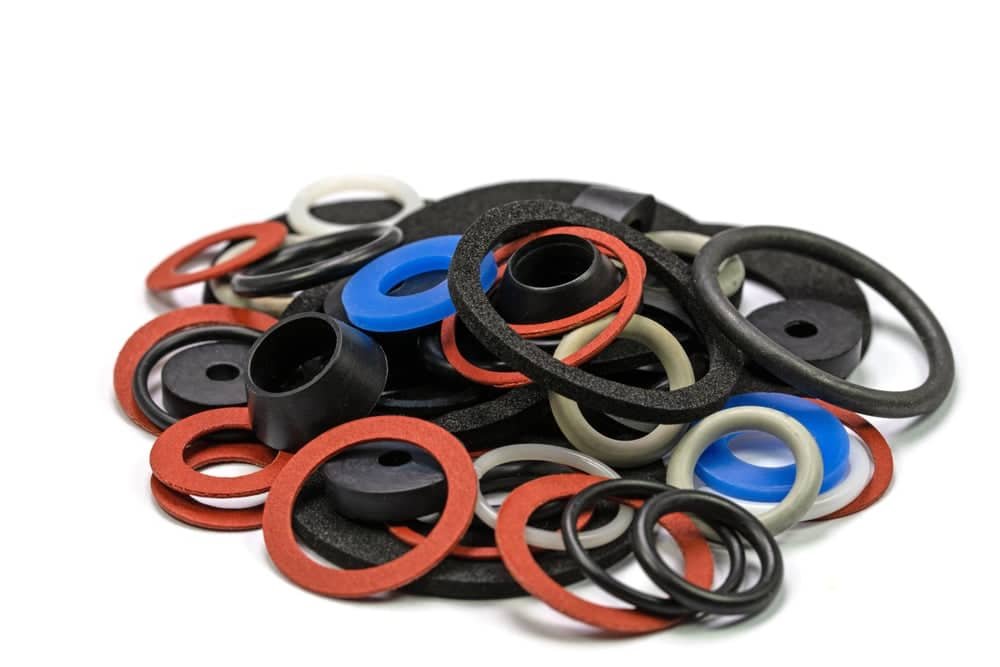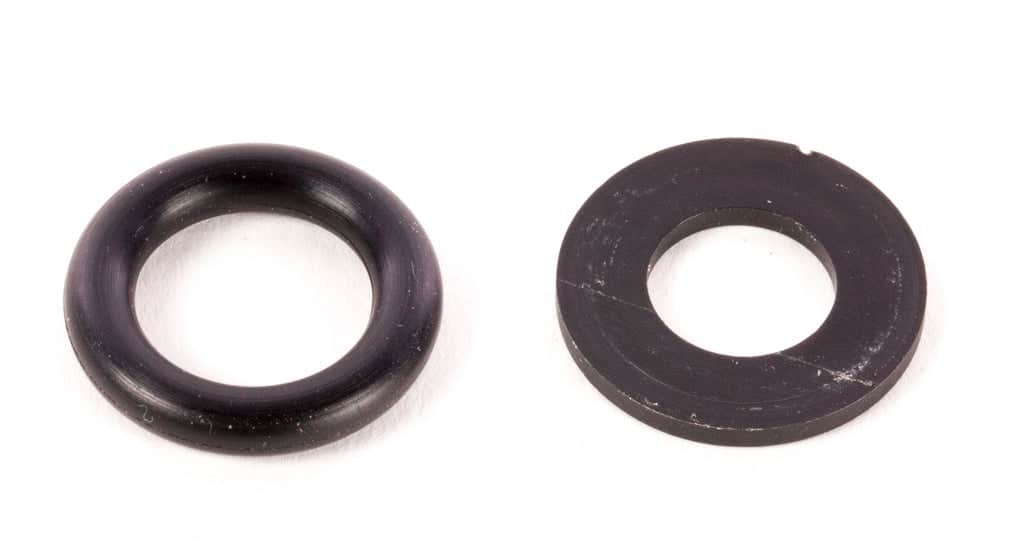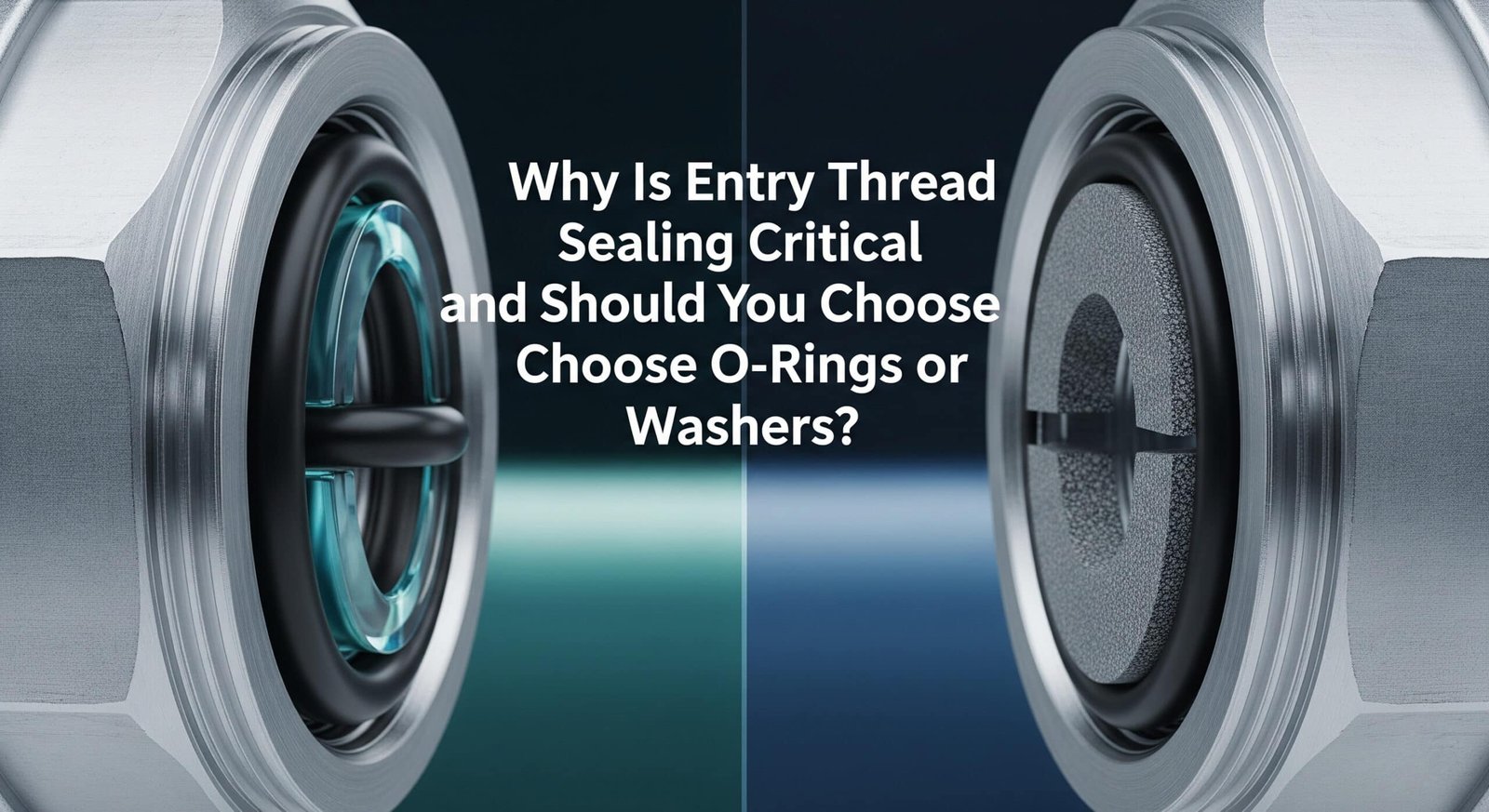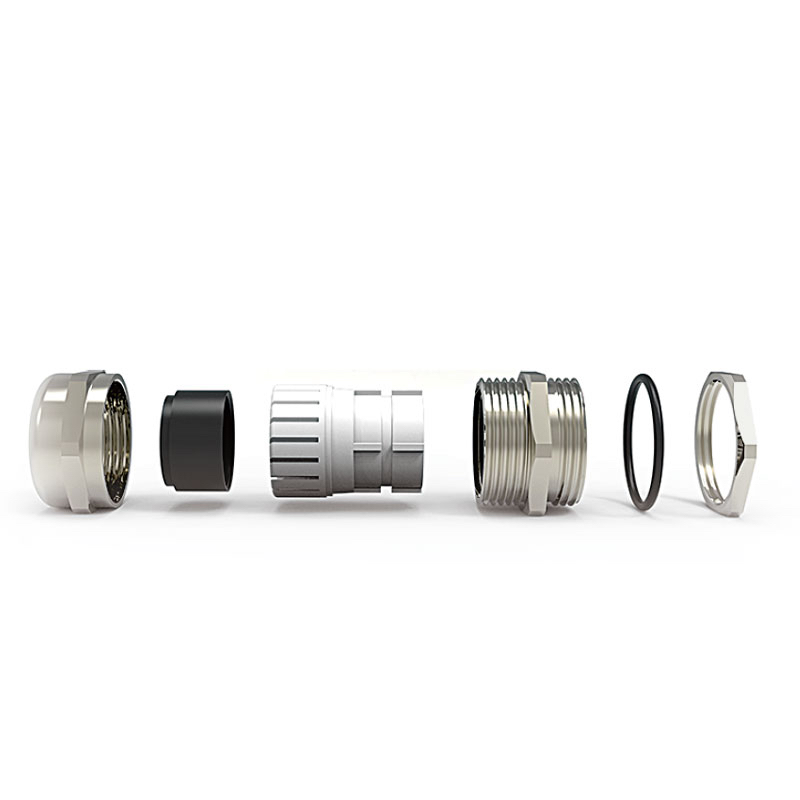
Sisselõike tihendamisrikked põhjustavad katastroofilisi seadmekahjustusi, elektrilisi ohte ja kulukaid seisakuid, kui niiskus, tolm ja saasteained tungivad kaabliühendustesse, kuid paljudes seadmetes kasutatakse ebapiisavaid tihendusmeetodeid, mis ebaõnnestuvad rõhu, temperatuuritsüklite või vibratsiooni tingimustes. Traditsioonilised lamedad seibid suruvad sageli ebaühtlaselt kokku, tekitavad lekkeid ja kaotavad aja jooksul tihendustõhususe, samas kui valesti valitud o-rõngad võivad rasketes tingimustes ekstrueeruda, praguneda või laguneda, jättes kriitilise tähtsusega seadmed keskkonnale vastuvõtlikuks.
Sisenemisniidi tihendamine on kriitilise tähtsusega, et säilitada IP-reitingud1 ja niiskuse sissetungi vältimiseks, kusjuures O-rõngad pakuvad 360-kraadise kontakti ja ühtlase kokkusurumise kaudu paremat tihendusvõimet, samas kui seibid pakuvad lihtsamat paigaldust, kuid piiratud tihendusvõimet, mistõttu O-rõngad on eelistatud valik nõudlike rakenduste puhul, mis nõuavad usaldusväärset pikaajalist kaitset. O-rõngaste ja seibide valik sõltub kasutusnõuetest, keskkonnatingimustest ja jõudluse ootustest.
Olles töötanud koos rajatiste juhtidega avamereplatvormidel Põhjameres, keemiatehastes Texases ja tootmisüksustes kogu Saksamaal, olen näinud omal nahal, kuidas õige sisselaskeava tihendamine võib teha vahet usaldusväärse töö ja kulukate rikete vahel. Lubage mul jagada kriitilisi teadmisi, et valida õige tihendusmeetod teie kaablitihenduste rakenduste jaoks.
Sisukord
- Miks on sisenemisniidi tihendamine kaablifiltrite puhul nii kriitiline?
- Kuidas võrdlevad O-rõngad ja seibid keermete tihendamist?
- Millal peaksite valima O-rõngad asemel pesurid?
- Millised on iga tihendusmeetodi parimad paigaldusviisid?
- Kuidas säilitada pikaajaline tihendusvõimekus?
- Korduma kippuvad küsimused sisenemisniidi tihendamise kohta
Miks on sisenemisniidi tihendamine kaablifiltrite puhul nii kriitiline?
Sisenemisniidi tihendus takistab niiskuse, tolmu ja saasteainete sisenemist elektrikappidesse kaabliühenduste kaudu, säilitades IP-klassi, ennetades korrosiooni ja tagades elektriohutuse, luues usaldusväärse barjääri karmide keskkondade ja korpuses asuvate tundlike seadmete vahele.
Keermete tihendamise kriitilise olemuse mõistmine on oluline, sest isegi väikesed tihendite rikked võivad põhjustada katastroofilisi kahjustusi seadmetele ja ohustada ohutust.
Keskkonnakaitse nõuded
Niiskuse sissetungi vältimine: Keermete tihendamine takistab vee sissetungi, mis võib põhjustada lühiseid, maandamisvigu ja seadmete korrosiooni, mis on eriti oluline välitingimustes, merel ja tööstuslikes pesukeskkondades.
Tolmu ja osakeste eemaldamine: Nõuetekohane tihendamine säilitab tolmu sissetungi kaitse (IP5X/IP6X), takistades peente osakeste sattumist korpusesse ja elektriühenduste või tundlike komponentide saastumist.
Keemiline vastupidavus: Keermetihendid peavad vastu pidama agressiivsetele kemikaalidele, õlidele ja lahustitele, mis võivad tihendusmaterjale lagundada ja kahjustada kaitset tööstuskeskkonnas.
Rõhkude erinevuse juhtimine: Tihendussüsteemid peavad toime tulema temperatuurimuutustest, kõrguse muutustest ja protsessitingimustest tingitud rõhkude erinevustega ilma terviklikkust kaotamata.
IP-klassifikatsioon Hooldus
IP-klassifikatsiooni standardid: Kaablifiltri keermete tihendamine mõjutab otseselt üldist korpuse IP-klassi, kusjuures nõuetekohane tihendamine on oluline IP65, IP67 või IP68 kaitsetaseme saavutamiseks ja säilitamiseks.
Testimisnõuded: IP-klassifikatsiooni kontrollimine eeldab, et keermete tihendus peab vastu pidama standardiseeritud veepritsmete, vee sisseimbumise ja tolmu sissetungimise testidele, ilma et see võimaldaks läbitungimist.
Sertifitseerimise vastavus: Paljud rakendused nõuavad kindlustuse, regulatiivse vastavuse ja ohutusstandardite jaoks sertifitseeritud IP-klassi, mistõttu on usaldusväärne keermetihendus kohustuslik.
Pikaajaline tulemuslikkus: IP-klassifikatsioon peab säilima kogu seadme eluea jooksul, mis nõuab vananemisele ja keskkonnakahjustustele vastupidavaid tihendusmaterjale ja -konstruktsioone.
Elektriohutusega seotud kaalutlused
Maasirge vältimine: Niiskuse tungimine läbi ebaõnnestunud keermetihenduse võib tekitada maandusvigu, mis lülitavad välja kaitseseadmed ja tekitavad elektrilisi ohte töötajatele.
Isolatsiooni terviklikkus: Vee sissetung võib vähendada isolatsioonitakistust ja tekitada jälgimisradasid, mis ohustavad elektriohutust ja seadmete tööd.
Kaarelõkkeohud: Ebaõnnestunud tihendamisest tulenev saastumine võib suurendada riski, et Arc Flash ohud2 hoolduse või rikete ajal.
Seadmete kaitse: Keermetihendus kaitseb kalleid elektriseadmeid keskkonnakahjustuste eest, mis võivad põhjustada enneaegset riket ja kulukat väljavahetamist.
Marcus, Saksamaal Stuttgardis asuva suure autotööstuse tehase hooldusjuht, sai teada, kui oluline on nõuetekohane keermete tihendamine tehase laiendamise käigus. Tema meeskond kasutas esialgu standardseid lamedaid seibikuid kriitiliste tootmisliinide juhtimisseadmeid teenindavate kaablipaigaldiste juures, arvates, et need tagavad piisava tihenduse. Esimese kõrgsurvepesutsükli ajal lekkisid mitmed kaablifiltrid, mistõttu puhastuskemikaalid tungisid juhtpaneelidesse ja põhjustasid 50 000 euro suurust kahju seadmetele ning kolm päeva tootmisseisakut. Me asendasime lamedad seibid kvaliteetsete NBR O-rõngastega, mis on kavandatud kemikaalikindlusele, kõrvaldades lekkeprobleemid ja tagades usaldusväärse kaitse agressiivsete puhastustsüklite ajal 😊.
Kuidas võrdlevad O-rõngad ja seibid keermete tihendamist?
O-rõngad pakuvad paremat tihendust tänu 360-kraadisele radiaalsele kokkusurumisele ja ühtlasele kontaktrõhule, samas kui seibid pakuvad lihtsamat paigaldust, kuid tuginevad pinnatihendusele, mida võivad ohustada pinna ebatasasused, ebaühtlane kokkusurumine ja materjali lagunemine, mistõttu on O-rõngad kriitilistes tihendusrakendustes usaldusväärsemad.
Nende tihendusmeetodite vaheliste põhiliste erinevuste mõistmine on oluline, et valida õige lähenemisviis teie rakenduse jaoks.
O-rõnga tihendusmehhanismid
Radiaalne kokkusurumine: O-rõngad tihendavad kontrollitud radiaalse kokkusurumise kaudu töödeldud soonetes, tagades ühtlase tihendusrõhu kogu ümbermõõdu ulatuses, olenemata paigaldusvariatsioonidest.
Energeetiline disain: Rõhkude erinevus tihendil pingestab O-rõngaid, suurendades tihendamisjõudu süsteemi rõhu kasvades, mistõttu on need ideaalsed surveanumate jaoks.
Materjali paindlikkus: O-rõngaste materjale saab valida vastavalt keemilisele ühilduvusele, temperatuurivahemikele ja keskkonnatingimustele, pakkudes suurepäraseid kohandamisvõimalusi.
Nutikaitse: Töödeldud sooned kaitsevad O-rõngaid kahjustuste eest paigaldamise ja kasutamise ajal, tagades samal ajal nõuetekohase kokkusurumise ja tihendusgeomeetria.

Pesuri tihendusomadused
Näo tihendamine: Seibid tekitavad tihendeid tasaste pindade vahelise aksiaalse kokkusurumise kaudu, mis nõuab tõhusaks tihendamiseks siledaid, paralleelseid pindu ja ühtlast pinguldamist.
Materjali deformatsioon: Tihendamine sõltub pesumaterjali deformatsioonist, et see kohanduks pinna ebatasasustele, kusjuures tõhusust piiravad materjali omadused ja pinna viimistlus.
Paigaldamise lihtsus: Pesurid ei nõua spetsiaalseid soone ega täpseid mõõtmeid, mistõttu on neid lihtsam paigaldada ja asendada välitingimustes.
Kulutõhusus: Standardseibid on tavaliselt odavamad kui O-rõngad ja soonelised komponendid, mis muudab need atraktiivseks kulutundlikes rakendustes.
Tulemuslikkuse võrdlustabel
| Tihendusaspekt | O-rõngad | Pesurid | Võitja |
|---|---|---|---|
| Tihendamise usaldusväärsus | Suurepärane 360° kontakt | Hea korralike pindadega | O-rõngad |
| Survekindlus | Energeetiline disain3 | Kompressiooniga piiratud | O-rõngad |
| Temperatuuri tsüklilisus | Säilitab elastsuse | Võib kaotada kompressiooni | O-rõngad |
| Keemiline vastupidavus | Materjalispetsiifilised valikud | Piiratud materjalivalik | O-rõngad |
| Paigaldamise lihtsus | Nõuab soont/täpsust | Lihtne drop-in disain | Pesurid |
| Kulud | Kõrgemad esialgsed kulud | Madalamad materjalikulud | Pesurid |
| Hooldus | Pikk kasutusiga | Sagedasem asendamine | O-rõngad |
| Vibratsioonikindlus | Säilitab kompressiooni | Võib aja jooksul lõdveneda | O-rõngad |
Materjalide valikud ja valik
O-rõnga materjalid: NBR (nitriil)4, EPDM, Viton®5, silikoon ja spetsiaalsed ühendid pakuvad spetsiifilist keemilist vastupidavust, temperatuurivahemikke ja toimivusomadusi nõudlike rakenduste jaoks.
Pesumasinate materjalid: Kautšuk, kork, kiud, metall ja komposiitmaterjalid pakuvad erineva tihendusvõime, keemilise vastupidavuse ja temperatuuritaluvuse tasemeid.
Keskkonnasõbralikkus: Materjalide valikul tuleb arvestada kemikaalide, äärmuslike temperatuuride, UV-kiirguse ja osooniga kokkupuutumist, et tagada pikaajaline hermeetilisus.
Õigusaktide järgimine: Mõned rakendused nõuavad spetsiifilisi materjalihinnanguid, nagu FDA, NSF või WRAS sertifikaat toidu-, ravimi- või joogiveega kokkupuutumiseks.
Millal peaksite valima O-rõngad asemel pesurid?
Valige O-rõngad kõrgsurve rakenduste, kriitiliste tihendusnõuete, karmide keemiliste keskkondade, äärmuslike temperatuuride ja pikaajalist töökindlust nõudvate olukordade jaoks, samal ajal kui seibid sobivad madala rõhu, kulutundlike rakenduste jaoks, kus on lihtne juurdepääs hooldusele ja standardsed keskkonnatingimused.
Otsus O-rõngaste ja seibide vahel peaks põhinema rakendusnõuete ja toimivuse ootuste süstemaatilisel hindamisel.
Suure jõudlusega rakendused
Survemahutite ühendused: Oluliste rõhuerinevustega rakendused nõuavad O-rõngaste iseenergiseerivaid omadusi ja usaldusväärset tihendamist muutuvates rõhutingimustes.
Ohtlikul alal asuvad rajatised: Plahvatusohtliku atmosfääri rakendused nõuavad kõrgeimat tihenduskindlust, et vältida süttimisallikate teket, mistõttu on O-rõngad eelistatud valik ohutuskriitilistes paigaldistes.
Mere- ja avamerepüük: Soolaprits, survepesu ja äärmuslikud ilmastikutingimused nõuavad O-rõngaste suurepärast keskkonnakindlust ja pikaajalist hermeetilisust.
Keemiline töötlemine: Agressiivsed kemikaalid ja lahustid võivad standardseid pesumaterjale kiiresti lagundada, samas kui spetsiaalsed O-rõngaühendid tagavad erilise keemilise vastupidavuse.
Kulutundlikud rakendused
Standardne tööstuslik: Üldistes tööstuslikes rakendustes, kus keskkonnatingimused on mõõdukad, võib pesureid tõhusalt kasutada, kui need on õigesti valitud ja hooldatud.
Ajutised rajatised: Lühiajalised või ajutised paigaldused, kus lihtne asendamine on vastuvõetav, võivad kasu saada pesuri lihtsusest ja madalamatest kuludest.
Madalrõhu süsteemid: Rakendustes, kus ei ole märkimisväärseid rõhkude erinevusi, on sageli võimalik saavutada piisav tihendus kvaliteetsete seibide ja nõuetekohase paigaldusega.
Suuremahulised paigaldused: Suurtes kogustes kaablipaigaldiste kasutamine mittekriitilistes rakendustes võib õigustada pesuri kasutamist kulude kokkuhoiu eesmärgil, kui hooldustöödele on hea juurdepääs.
Keskkonnaalased kaalutlused
Temperatuuritsüklilisus: Oluliste temperatuurivahetustega rakendused nõuavad O-rõngaste võimet säilitada tihendavus läbi soojuspaisumise ja kokkutõmbumise tsüklite.
Vibratsioonikeskkonnad: Vibratsioonile allutatud masinad ja seadmed saavad kasu O-rõngaste vastupidavusest lõtvumise ja tihendite lagunemise suhtes dünaamilistes tingimustes.
UV-kiirgus: Välitingimustes kasutamiseks on vaja UV-kindlaid tihendusmaterjale, mille spetsiaalsed O-rõngad pakuvad parimat vastupidavust ilmastikutingimustele.
Keemiline puhastus: Agressiivset puhastamist nõudvad toiduainetetööstuse ja farmaatsiatööstuse rakendused saavad kasu O-rõngaste keemilisest vastupidavusest ja puhastatavusest.
Hassan, kes juhib Saudi Araabias Jubailis asuvat naftakeemiatööstuse rajatist, seisis silmitsi keeruliste tihendusnõuetega kriitiliste ohutusseadmete kaablipaigaldiste puhul. Äärmuslikud temperatuurivahetused (50 °C ümbritsevast temperatuurist kuni -20 °C veeldatud maagaasi töötlemise ajal) koos kokkupuutega süsivesinikuaurude ja kõrgsurvepesu nõuetega muutsid standardpesurid ebasobivaks. Tema esialgsed pesuriga suletud paigaldused läksid kuue kuu jooksul katki, põhjustades ohutussüsteemi häireid ja probleeme regulatiivsete nõuete täitmisega. Me varustasime kaablipaigaldised Viton® O-rõngaste tihendussüsteemidega, mis on kavandatud süsivesinikukindlusele ja äärmuslikele temperatuuritsüklitele, saavutades viis aastat usaldusväärset tööd ilma tihendite riketeta ja säilitades täieliku regulatiivse vastavuse.
Millised on iga tihendusmeetodi parimad paigaldusviisid?
Korralik paigaldamine nõuab iga tihendusmeetodi jaoks spetsiifilisi tehnikaid, kusjuures O-rõngad vajavad hoolikat soonte kontrollimist, määrimist ja kokkusurumise kontrollimist, samas kui seibid vajavad pinna ettevalmistamist, nõuetekohast pöördemomendi rakendamist ja joondamise kontrollimist, et saavutada optimaalne tihendusvõime ja pikaealisus.
Paigalduskvaliteet mõjutab otseselt tihendite toimivust ja kasutusiga, mistõttu on usaldusväärse töö tagamiseks oluline õige tehnika.
O-rõnga paigaldamise protseduurid
Nopete kontrollimine: Kontrollige soonte mõõtmeid, pinna viimistlust ja seda, et need ei sisaldaks kriimustusi, kriimustusi või saastumist, mis võivad kahjustada tihendusrõngast või kahjustada tihendust.
O-rõnga valik: Enne paigaldamist veenduge, et O-rõnga suurus, materjal ja kõvadus on konkreetse rakenduse jaoks õige, kontrollides kahjustusi, vananemist või saastumist.
Määrimine Kohaldamine: Paigaldage sobivat määrdeainet, et hõlbustada paigaldamist ja vältida O-rõnga kahjustusi, kasutades sobivaid määrdeaineid, mis ei kahjusta tihendi materjali.
Paigaldustehnika: Paigaldage O-rõngad ilma väänamata, venitamata või pigistamata, kasutades õigeid tööriistu ja tehnikaid, et vältida vigastusi kokkupaneku ajal.
Pesumasina paigaldamise parimad praktikad
Pinna ettevalmistamine: Veenduge, et ühenduspinnad on puhtad, tasased ja ilma kriimustuste, korrosiooni või prahist, mis võivad takistada seibide nõuetekohast kokkusurumist ja tihendamist.
Pesuri kontroll: Kontrollige seibide kahjustusi, õiget suurust ja materjali seisukorda, asendades kõik seibid, millel on vananemise, pragunemise või deformatsiooni tunnused.
Pöördemomendi rakendamine: Rakendage nõuetekohane pöördemoment kalibreeritud tööriistade abil etappide kaupa, järgides tootja spetsifikatsioone, et saavutada ühtlane kokkusurumine ilma ülepingutamiseta.
Kohandamise kontrollimine: Tagage keermestatud komponentide nõuetekohane joondamine, et vältida seibide ebaühtlast kokkusurumist ja võimalikku tihendi rikkeid.
Tavalised paigaldusvigad
Ülekompressioon: Liigne pingutamine võib kahjustada töörõngaid või seibikuid, vähendades tihendamise tõhusust ja kasutusiga ning põhjustades samas potentsiaalselt komponentide rikkeid.
Alakompressioon: Ebapiisav kokkusurumine ei taga nõuetekohast tihendust, mis võimaldab lekkeid ja keskkonda tungimist, mis kahjustab tihendussüsteemi eesmärki.
Ristisuunaline lõimimine: Keermete ebakorrektne haakumine võib kahjustada komponente ja takistada nõuetekohast tihendamist, mistõttu tuleb monteerimisel hoolikalt jälgida keermete joondamist.
Saastumine: Mustus, prahi või kokkusobimatud materjalid võivad kahjustada tihendi toimivust, mistõttu on vajalik puhas kokkupanek ja materjalide nõuetekohane käitlemine.
Kvaliteedikontrolli meetmed
Pöördemomendi kontrollimine: Kasutage kalibreeritud pöördemomendi tööriistu ja järgige ettenähtud pingutusjärjekorda, et tagada tihendi ühtlane ja nõuetekohane kokkusurumine kõikides paigaldustes.
Lekkekatse: Enne seadme kasutusele võtmist tuleb teha asjakohane lekkekatse, kasutades rõhu, vaakumi või jälgimismeetodit, et kontrollida tihenduse terviklikkust.
Dokumentatsioon: Salvestage paigaldamise üksikasjad, sealhulgas pöördemomendi väärtused, tihendusmaterjalid ja katsetulemused hoolduse planeerimiseks ja tõrkeotsinguks.
Koolitusnõuded: Tagada, et paigalduspersonal mõistab õigeid tehnikaid ja et tal on juurdepääs asjakohastele tööriistadele ja materjalidele, mis on vajalikud kvaliteetseks paigaldamiseks.
Kuidas säilitada pikaajaline tihendusvõimekus?
Pikaajaline tihendite toimivus nõuab regulaarseid ülevaatusgraafikuid, õigeid vahetamisintervalle, keskkonnaseiret ja ennetavaid hooldusprogramme, mis käsitlevad tihendite lagunemist, materjalide ühilduvust ja muutuvaid töötingimusi, et tagada pidev kaitse kogu seadme kasutusaja jooksul.
Hoolduse planeerimine on kriitilise tähtsusega, sest tihendussüsteemid võivad järk-järgult laguneda ilma ilmsete märkideta, kuni tekib katastroofiline rike.
Inspekteerimis- ja järelevalveprogrammid
Visuaalne kontroll: Kaablitihendite regulaarne visuaalne kontroll lekke, korrosiooni või füüsiliste kahjustuste suhtes, mis võivad viidata tihendi lagunemisele või rikkele.
Tulemuslikkuse testimine: Tihenduse terviklikkuse perioodiline kontrollimine asjakohaste meetoditega, nagu rõhu katsetamine, isolatsioonitakistuse mõõtmine või lekke tuvastamine.
Keskkonnaseire: Keskkonnatingimuste, sealhulgas temperatuuri, keemilise kokkupuute ja UV-kiirguse jälgimine, mis võivad aja jooksul mõjutada tihendusmaterjali omadusi.
Seisundi hindamine: Tihendi seisundi süstemaatiline hindamine, mis põhineb hoolduse ajaloost, keskkonnaga kokkupuutest ja tootja soovitustest vahetamisintervallide kohta.
Ennetava hoolduse strateegiad
Plaaniline asendamine: Tihenduskomponentide ennetav väljavahetamine, mis põhineb kasutusaja andmetel, keskkonnatingimustel ja rakenduse kriitilisusel.
Materjalide uuendamine: Paremate tihendusmaterjalide kasutuselevõtt, kui töötingimused muutuvad või paremad materjalid muutuvad kättesaadavaks.
Süsteemi parandused: projekteerimise parandamine, näiteks parem drenaaž, ventilatsioon või kaitse, et vähendada tihendussüsteemidele avalduvat keskkonnakoormust.
Varuosade haldamine: Asendustihendite asjakohase varu säilitamine koos nõuetekohaste ladustamistingimustega, et tagada materjali kvaliteet vajaduse korral.
Tihendi tõrkeotsing
Rikkeanalüüs: ebaõnnestunud tihendite süstemaatiline analüüs, et teha kindlaks algpõhjused, sealhulgas materjali lagunemine, paigaldusvigad või konstruktsiooni puudused.
Parandusmeetmed: Asjakohaste parandusmeetmete rakendamine, näiteks materjalide muutmine, paigaldusprotseduuride parandamine või konstruktsiooni muutmine.
Tulemuslikkuse jälgimine: Tihendi toimivuse paranemise jälgimine pärast parandusmeetmete võtmist, et kontrollida tõhusust ja optimeerida hooldusstrateegiaid.
Dokumentatsioon: Pidevate parendusprogrammide jaoks üksikasjalike vigade, parandusmeetmete ja tulemuslikkuse parandamise dokumentide säilitamine.
Kokkuvõte
Sisselõike tihendamine on seadmete kaitse ja ohutuse säilitamiseks kriitilise tähtsusega, kusjuures valik O-rõngaste ja seibide vahel sõltub kasutusnõuetest, keskkonnatingimustest ja jõudluse ootustest. O-rõngad pakuvad nõudlike rakenduste jaoks parimat tihendusvõimet, seibid aga vähem kriitiliste paigalduste jaoks kuluefektiivseid lahendusi.
Edu tihendusrakenduste puhul eeldab tihendusmeetodite põhiliste erinevuste mõistmist, õiget materjalivalikut, õigeid paigaldustehnikaid ja asjakohaseid hooldusprogramme. Bepto pakub nii O-rõnga- kui ka seibitihenduslahendusi koos tehniliste oskustega, mis aitavad teil valida õige lähenemisviisi teie konkreetse rakenduse nõuetele, tagades usaldusväärse pikaajalise toimivuse ja kaitse.
Korduma kippuvad küsimused sisenemisniidi tihendamise kohta
K: Milline on peamine erinevus O-rõnga- ja seibitihendi vahel?
A: O-rõngad tagavad 360-kraadise radiaalse survetihenduse soontes, samas kui seibid loovad näotihendeid tasaste pindade vahelise aksiaalse survetihenduse kaudu. O-rõngad tagavad parema tihenduskindluse ja survekindluse, seibid on aga lihtsam ja odavam paigaldada.
K: Kuidas ma tean, millal tuleb kaabli tihendid välja vahetada?
A: Vahetage tihendid välja, kui märkate nähtavaid pragusid, kõvenemist või deformatsiooni, kui lekkekatse ebaõnnestub või kui tootja soovitatud hooldusintervallidel põhinevalt. Keskkonnategurid, nagu kemikaalidega kokkupuutumine ja temperatuuritsüklid, võivad kiirendada asendamise vajadust.
K: Kas ma võin olemasolevatel kaablitihenditel vahetada seibid O-rõngaste vastu?
A: Täiendamine sõltub kaabli tihendi konstruktsioonist ja sellest, kas sellel on nõuetekohased O-rõnga sooned. Mõned kaablifiltrid on mõeldud mõlema tihendusmeetodi jaoks, samas kui teised vajavad täielikku väljavahetamist O-rõngaga tihendussüsteemide jaoks.
K: Mis põhjustab kaabli tihenduskeerme rikkeid?
A: Levinumad põhjused on vale paigaldusmoment, kokkusobimatud tihendusmaterjalid, pinna saastumine, ülepingutamise kahjustused, keskkonnakahjustused ja tavapärane vananemine. Korralik materjalivalik ja paigaldustehnika hoiab ära enamiku rikete tekkimise.
K: Kuidas valida õige tihendusmaterjal oma rakendusele?
A: Võtke arvesse töötemperatuuride vahemikku, keemilist kokkupuudet, rõhunõudeid ja keskkonnatingimusi. NBR sobib üldiste rakenduste jaoks, EPDM ilmastikukindluse jaoks ja Viton® keemilise ühilduvuse jaoks. Konkreetsete kemikaalide puhul vaadake materjalide ühilduvuse tabelit.
-
Vaata üksikasjalikku tabelit, mis selgitab, mida tähendab iga IP-kategooria number tahkete ja vedelike kaitse puhul. ↩
-
Lugege ametlikku ohutusjuhendit, mis käsitleb elektrivalguse põhjuseid ja selle vältimise standardeid. ↩
-
Vaadake tehnilist animatsiooni, mis näitab, kuidas rõhk aitab O-rõngal luua tihedamat tihendit. ↩
-
Vaadake materjali omaduste juhendit, et näha, kuidas NBR (nitriil) käitub erinevate kemikaalidega. ↩
-
Tutvuge Viton® (FKM) keemilise ühilduvuse tabeliga, et hinnata selle kasutamist karmides keskkondades. ↩



